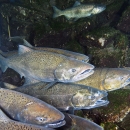
Upriver bright (URB) fall Chinook salmon reared and released from the Little White Salmon and Willard National Fish Hatcheries are known to stray into the White Salmon River. Interactions between hatchery-origin URB strays and ESA-listed tule fall Chinook salmon are believed to lead to a loss in productivity of the native tule population through hybridization and redd superimposition. Tule fall Chinook salmon generally spawn earlier in the fall (September – October), which puts their redds at risk of superimposition by URB fall Chinook salmon that typically spawn later (late October – November). Superimposition may result in egg displacement and reduce egg-to-fry survival leading to a loss in productivity of the tule fall Chinook population. A pilot feasibility study was conducted in the fall (September – November) of 2022 to assess the superimposition of tule redds by URB fall Chinook salmon within the lower White Salmon River. Redd locations were documented during weekly spawning ground surveys using ArcGIS Field Maps and an Arrow RTK GNSS Receiver resulting in centimeter-level location accuracy. The degree of overlap and level of disturbance to tule redds were used to document superimposition. A surprisingly high incidence (71 percent) of tule redds were superimposed by URBs, with approximately 88 percent of all tule redds surveyed disturbed in some way. These results draw further attention to the potential impacts of hatchery-origin URBs on the ESA-listed tule population. Herein we present results from the pilot feasibility study, evaluate the methodology employed, discuss potential management implications, and suggest future studies to measure the impacts of superimposition.






